List of Contents
Log Management Market Size and Forecast 2025 to 2034
The global log management market size is projected to be worth around USD 10.08 billion by 2034 from USD 3.27 billion in 2024, at a CAGR of 11.92% from 2025 to 2034. The North America log management market size reached USD 1.28 billion in 2024. Expansion of the IT environment increases complexity and, thus, needs to be managed in terms of security purposes to comply with stringent government regulations, which are the major driving factors that propel the global log management market.
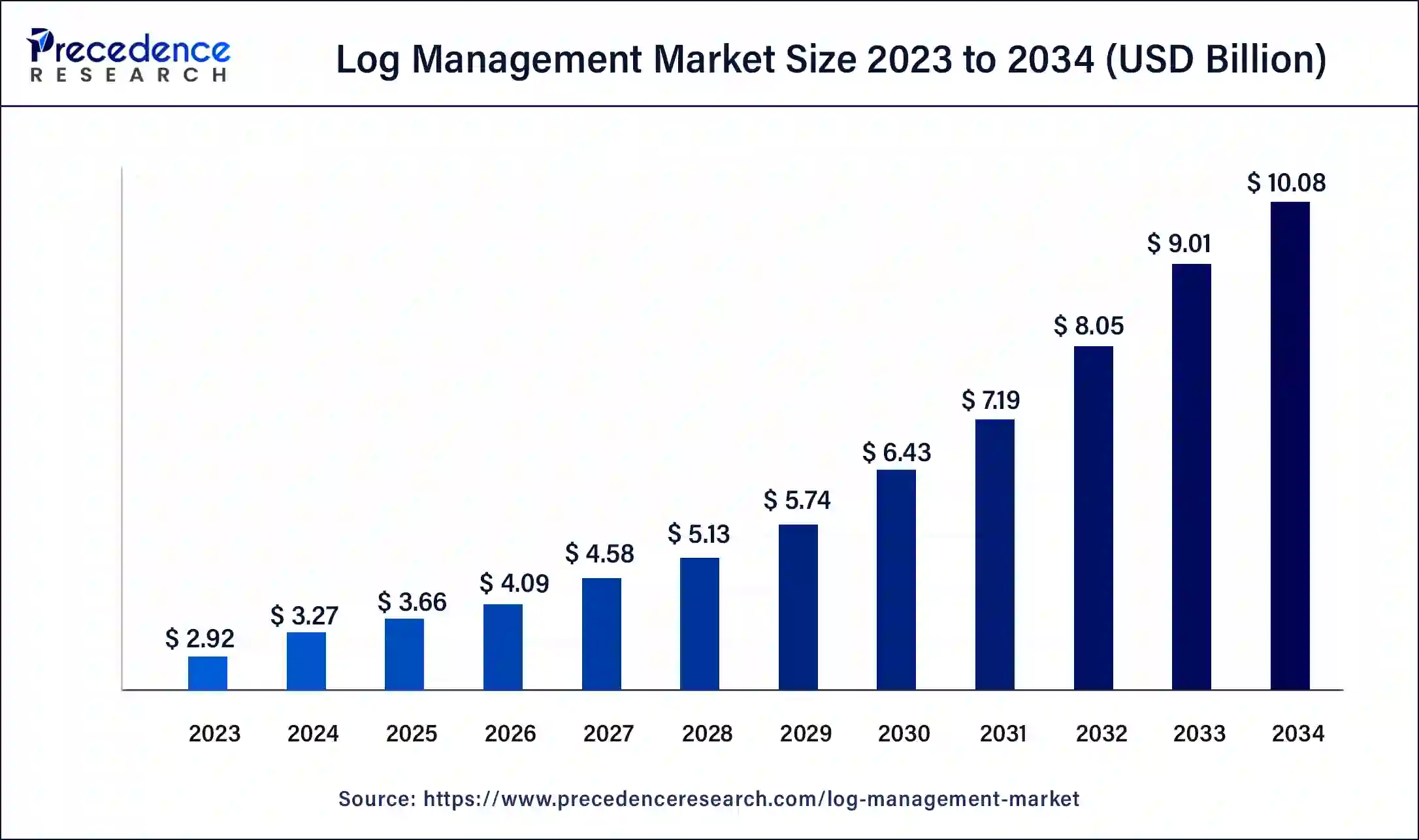
Log Management Market Key Takeaways
- The global log management market was valued at USD 3.27 billion in 2024.
- It is projected to reach USD 10.08 billion by 2034.
- The log management market is expected to grow at a CAGR of 11.92% from 2025 to 2034.
- North America accounted for the largest market share of 39% in 2024.
- Asia Pacific is expected to host the fastest-growing market during the studied period.
- By component, the solution segment generated the largest market share of 79% in 2024.
- By component, the service segment is expected to grow at the fastest rate in the market over the forecast period.
- By deployment, the cloud segment contributed the highest market share of 68% in 2024.
- By organization size, the large enterprises segment held a substantial market share of the market in 2024.
- By vertical, the IT & ITeS segment led the global market in 2024.
AI Impact on the Log Management Market
AI has a substantial impact on the log management market. Hence, log management solutions are rapidly evolving with the use of machine learning and AI algorithms, which help automate the analysis of logs with anomaly detection. Such practices by using advanced analytics facilitate responding quickly to security threats, ongoing operational problems, and performance loopholes more precisely, which in turn reduces the extra load on the IT team while regulating the response time effectively within the time frame.
A major priority for companies is compliance with industrial regulations and laws set for data protection. Hence, log management solutions have come with in-built functionalities that support and adhere to these regulations for simplification and aid in streamlining industrial operations, according to the lawsuit. Such innovative offerings are introduced with the help of AI in the log management market, further fuelling the growth of the market on a larger scale.
U.S. Log Management Market Size and Growth 2025 to 2034
The U.S. log management market size was exhibited at USD 890 million in 2024 and is projected to be worth around USD 2,810 million by 2034, poised to grow at a CAGR of 12.18% from 2025 to 2034.
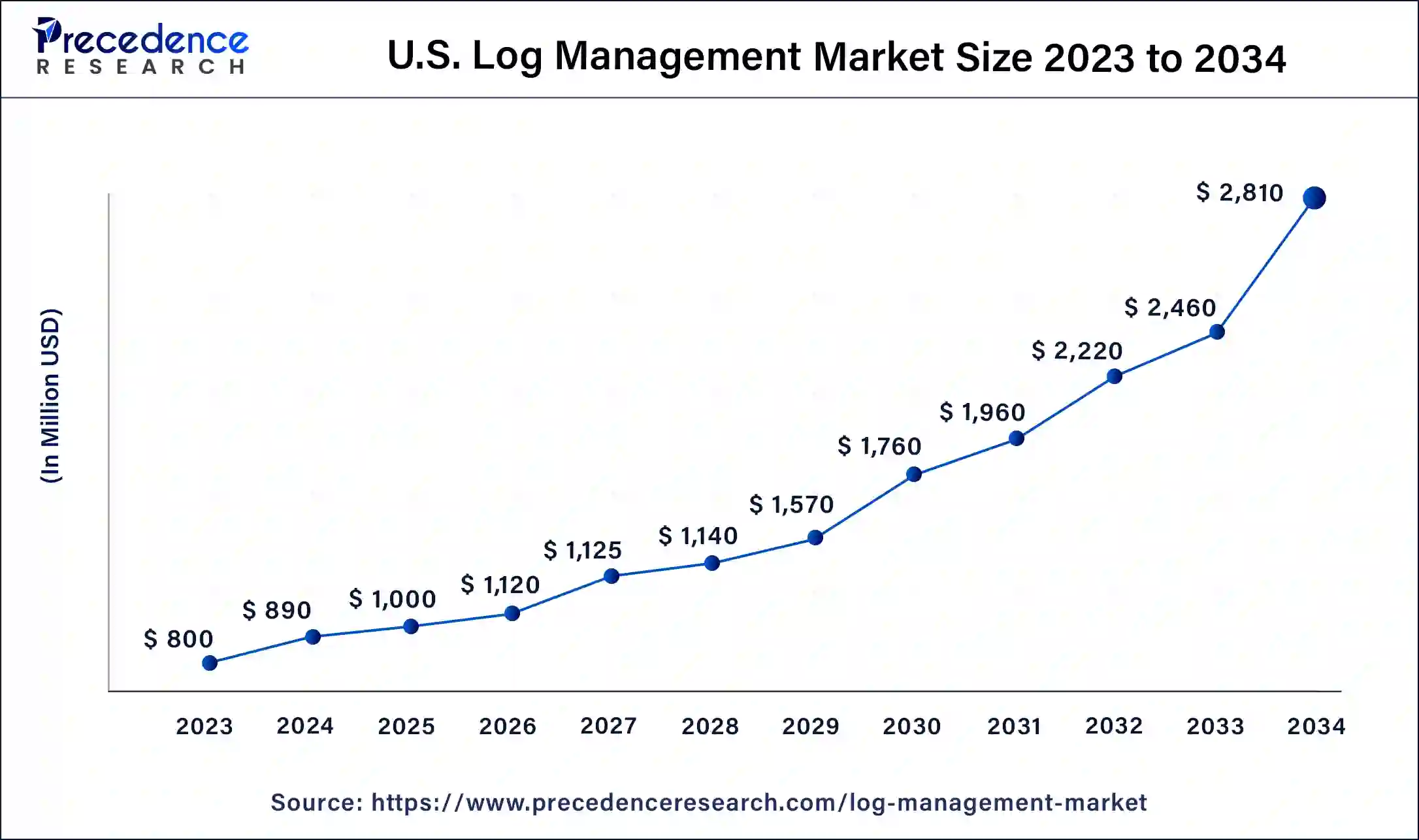
North America accounted for the largest share of the global log management market in 2024. The dominance of this segment is majorly attributed to two of the leading countries, the U.S. and Canada, in North America, propelling the log management market growth further. The region has the most advanced technologies and well-established digital infrastructure with robust measurement for security purposes to combat unauthorized access to log data.
To secure the IT infrastructure, with consistent threats like advanced persistent threats APTs and planned cyber-attacks, the demand for advanced log management solutions has significantly increased in the past few years. Again, the region boasts widely developing SMEs and well-rooted large enterprises where implementation for log management solutions is a top priority to compliance with stringent regulations about data security, further propelling the global log management market in North America.
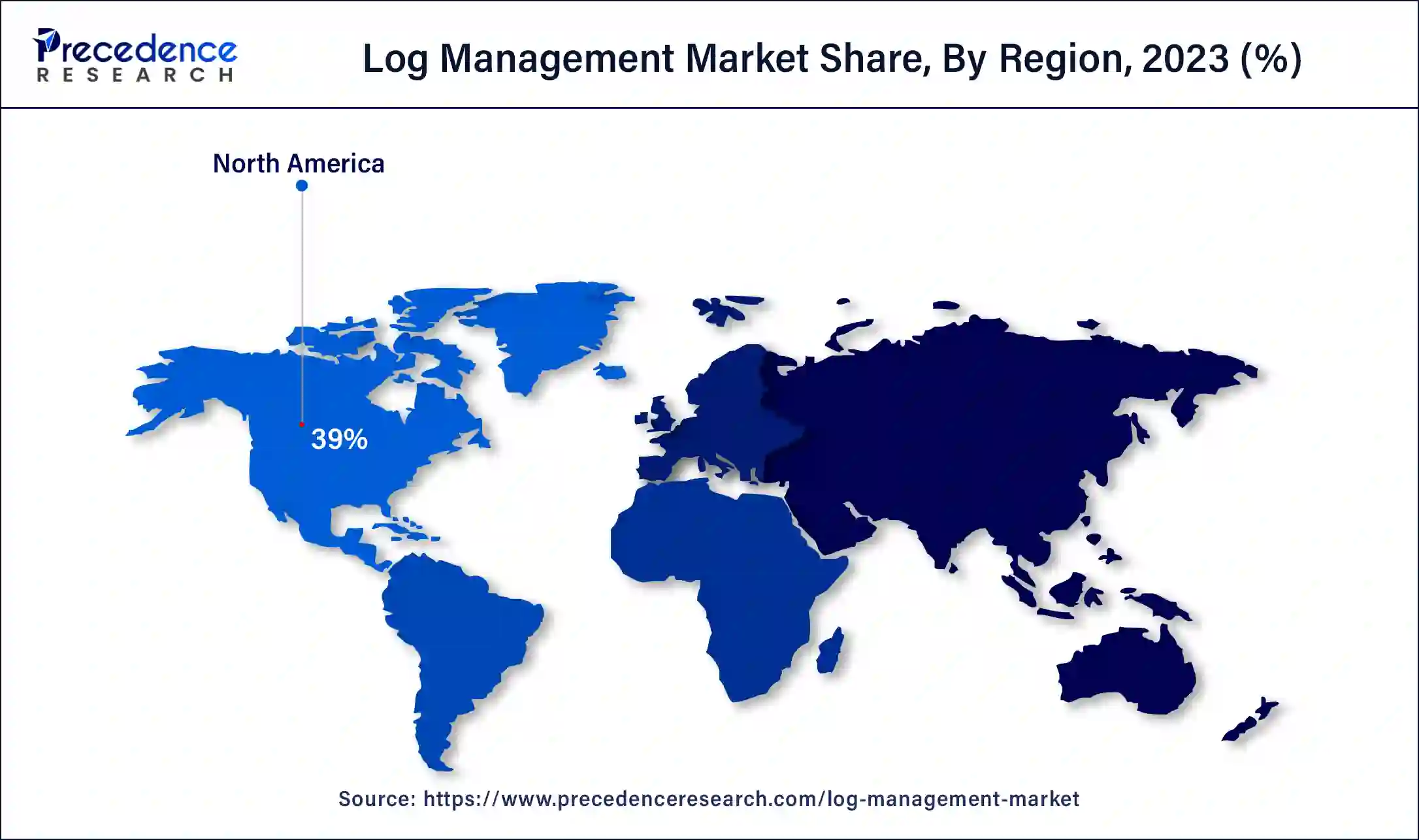
Asia Pacific is expected to host the fastest-growing log management market during the studied period. The growth of this segment is attributed to factors like the rising adoption of mobile communication devices, and developing nations like India, China, and Japan are inclining towards rapid digitalization in every sector, fuelling the market's demand on a global scale.
Economically evolving countries like India are adopting rapid digitalization, which is enabled and supported by government initiatives like ‘Digital India' and presents lucrative opportunities that help build the nation's economy and are a significant contributor to the log management market in Asia Pacific.
Market Overview
Over the past few years, the global IT infrastructure has drastically changed from large enterprises to recently opened startups, and everyone is slowly moving towards cloud-based applications. The global IT sector is continuously in a state of flux; hence, IT teams need to pay attention to maintain complete visibility of all components their applications are exposed to, as well as the underlying infrastructure. Logs are basically every application run by the user, server, workstation, and networking devices that are registered. They are called logs. There are various log formats, but to minimize the complexity of monitoring, it is preferable to use a standard format like JSON across the IT sector.
Moreover, increasing demand for cybersecurity across various sectors and strict government rules to protect sensitive data privacy are some of the fuelling factors of the log management market. The rapid adoption of digitalization across the globe in every sector, like retail, communication, and BFSI, along with the rising use of mobile applications, creates a huge amount of data that needs to be managed efficiently.
Log Management Market Growth Factors
- Rising concerns about data breaches and hacking from unauthorized sites.
- Rising demand for a fast-paced monitoring system to analyze and real-time monitoring for logs.
- Increasing shift towards cloud-based solutions and services and hybrid IT demands.
- Stringent regulations like HIPPA and GDPR demand organizations to keep logs for longer periods for audit purposes.
- Increasing complexity of IT departments in the organizations.
- The exponential increase in IoT devices creates a vast amount of log data that needs to be managed efficiently.
- Businesses are seeking cost optimization solutions and a rising focus on core work to proliferate the business.
Market Scope
| Report Coverage | Details |
| Market Size by 2034 | USD 10.08 Billion |
| Market Size in 2025 | USD 3.66 Billion |
| Market Size in 2024 | USD 3.27 Billion |
| Market Growth Rate from 2025 to 2034 | CAGR of 11.92% |
| Largest Market | North America |
| Base Year | 2024 |
| Forecast Period | 2025 to 2034 |
| Segments Covered | Component, Deployment, Organization Size, Vertical, and Regions |
| Regions Covered | North America, Europe, Asia-Pacific, Latin America and Middle East & Africa |
Market Dynamics
Driver
Remote monitoring with better system performance
A significant driving factor for the log management market is log monitoring can be done remotely, which further saves time and enhances system performance all at once. In the past, log monitoring was only part of a small IT enterprise, as log monitoring was performed manually. Because large networks and systems were difficult to monitor manually with efficiency. But, in the modern days of the IT sector, it is possible to keep tabs on local and remote events as well by using monitoring software. Such a centralized approach for log monitoring is immensely manageable as it offers to keep relevant logs in the same place. Also, customization can be done on log monitoring to determine which logs can be kept and which can be ignored by using various processes.
Moreover, such an approach for log monitoring can enhance the security of the system. Log monitoring software, when associated with a memory bank having huge data capacity, again allows it to save past logs perfectly with security. If logs are bulkier than usual, then there are automation features incorporated with technically sound software, which makes monitoring a faster pace than the manual method and minimizes downtime in the scenario of critical errors.
Restraint
Poor scalability with storage constraint
The major drawbacks to the evolution of the log management market are low scalability and storage concerns. As log management often creates a huge amount of data with every entry, it is essential to have a robust storage infrastructure with the option for archiving past data to free up the space for recent log data. However, by looking at this urgency for high storage, log data storage systems are still not highly scalable or sufficient to store every entry. Most of the log data is kept in the local server and local hard drives, which have their data storage limitations.
According to some regulatory compliance, it is almost mandatory to keep every log data for many years or maybe even permanently, as it is essential for the audit process to identify a particular loophole in the system. But, on average, log data can be kept up to a month or, most probably, for several extended months.
Opportunity
Adoption of cloud-native application
A significant opportunity that the log management market holds is the rapid adoption of cloud-based applications and microservice applications. Businesses are continuously seeking to transfer their work into cloud platforms and to develop applications. For that, the complexity of IT systems has immensely increased in the past few years owing to this inclination.
While conventional methods for log monitoring are not scalable solutions in this ever-changing environment, there is an increasing demand for scalable solutions, which gives rise to Kubernetes and serverless computing features. These technologies generate a huge amount of log data that needs to be monitored in real-time to ensure security and performance. Hence, features like automated anomaly detection, real-time analytics, and seamless integration of DevOps pipelines are introduced in the market, further opening the lucrative opportunity for the proliferation of the log management market on a wider scale.
Component Insights
The solution segment accounted for the largest share of the log management market in 2024. The growth of this segment is attributed to factors such as the comprehensive ability to address the crucial needs of the organization. The essential components like threat detection, automation, and real-time analysis of logs with adherence to regulatory needs are offered by the solution segment, thus fuelling the growth of the market.
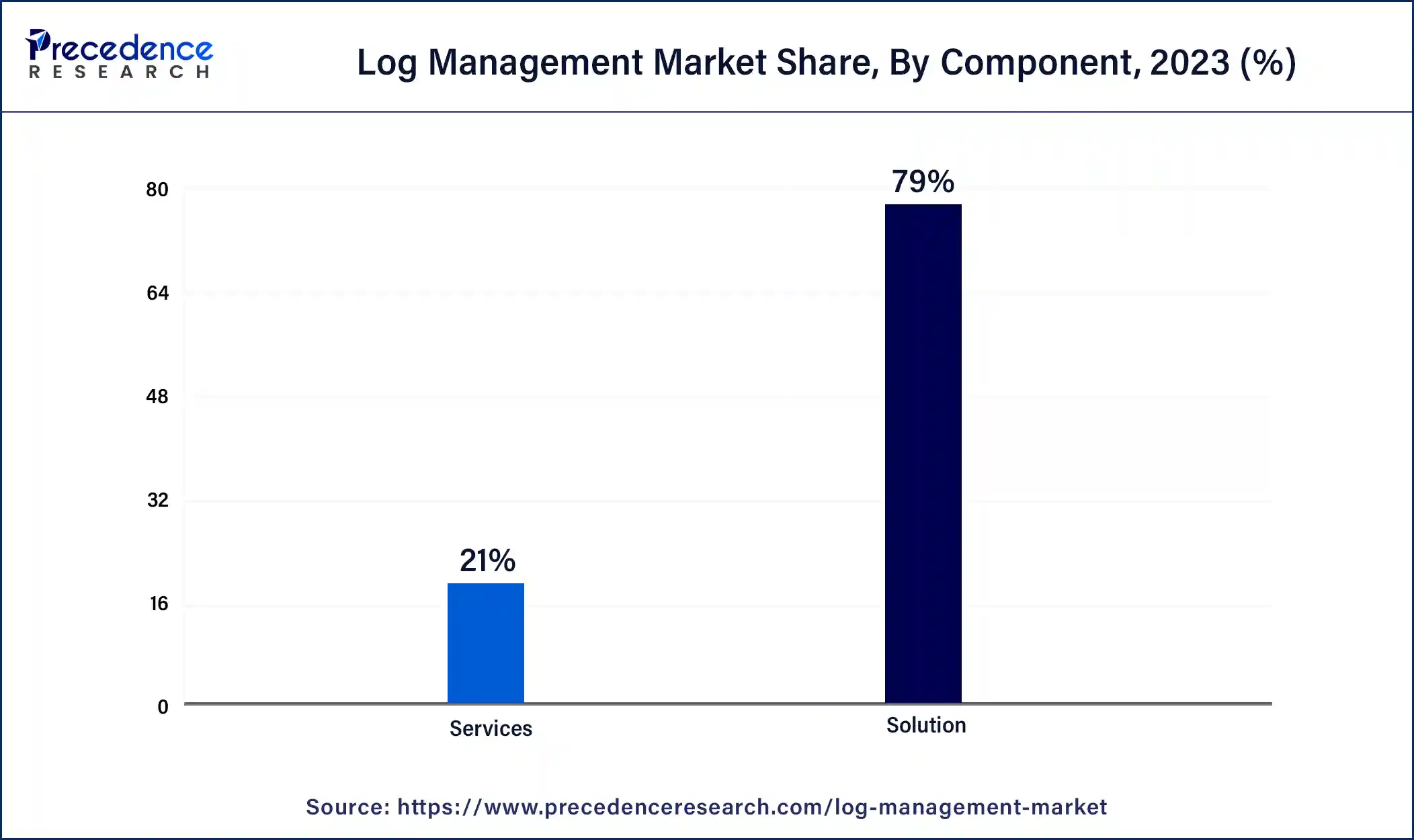
The demand for robust log management is highly increasing as enterprises are constantly in need to combat cyber security threats, which is provided by solutions. Again, the scalability and flexibility offered by cloud-based solutions are propelling the market in the forward direction, helping organizations to efficiently handle the vast amount of log data across various sectors.
The service segment is expected to grow at the fastest rate in the log management market over the forecast period. The service segment in the log management market is fuelling noticeably due to the increasing demand for handling the complex IT infrastructure in various organizations. Enterprises are inclined to manage services and consult for efficiently deploying and customizing the log management solution. This shift allows companies to feel protected from cybersecurity threats and allows them to focus on core business activities that help proliferate and strengthen their roots in the market.
Deployment Insights
The cloud segment holds a significant share of the global log management market. The growth of the cloud segment in the log management market is propelling, owing to multiple factors like scalability, flexibility, and cost-effectiveness. Therefore, businesses are rapidly inclining towards a robust cloud-based infrastructure. Companies are seeking solutions that can be integrated with a cloud-based environment.
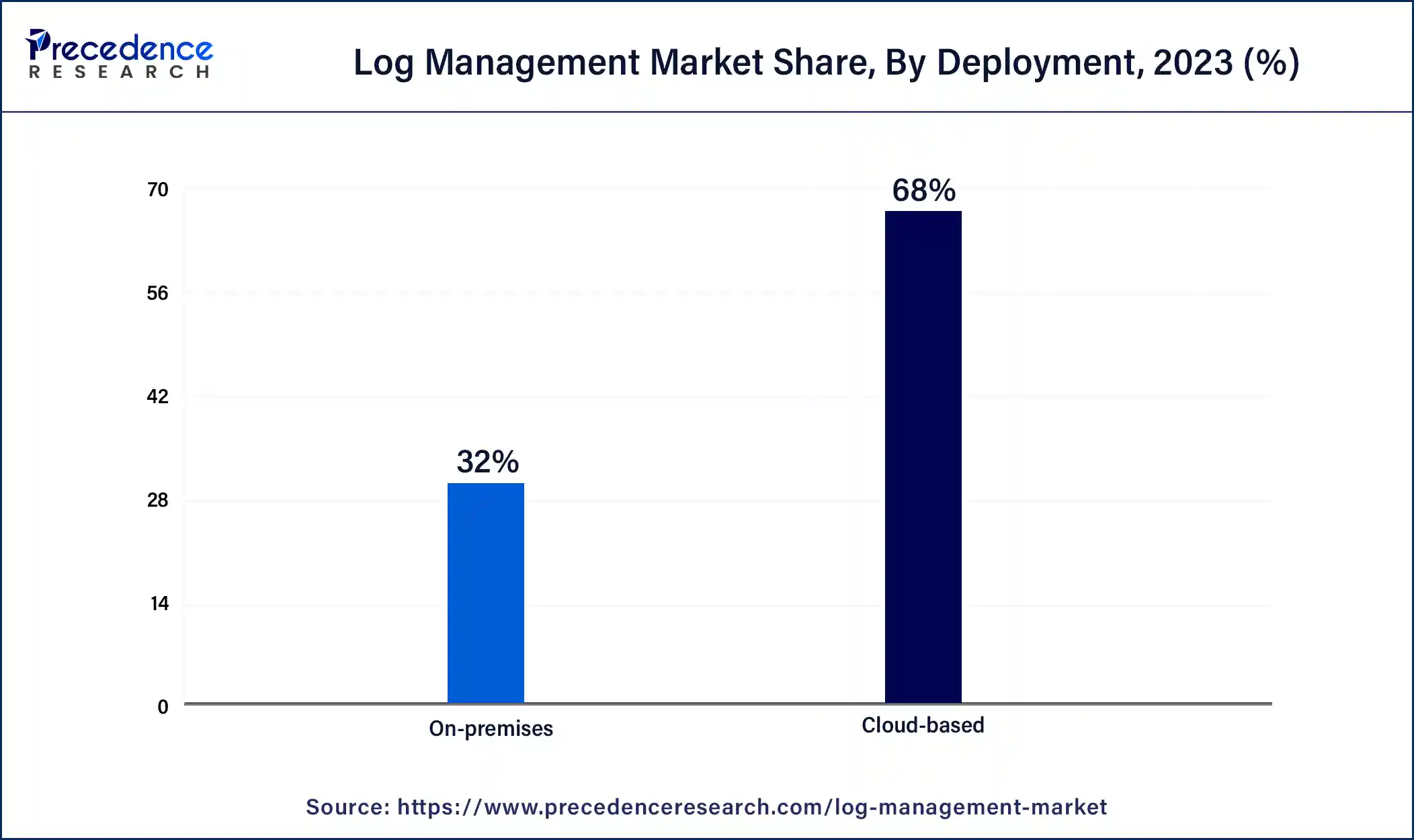
It helps to scale their operations at ease while managing huge amounts of log data at once without a massive investment needed to build robust hardware. Moreover, the increasing remote work has propelled the adoption of cloud-based operations since they allow real-time monitoring and management even from remote locations without the need for the physical presence of the employees. This creates flexibility for time location, fuelling and expanding the core business activities.
Cloud-based log management services
| Services | Integration with compatibility | Real-time alert notice | Advanced security analytics |
| ManageEngine Log360 | 12 major third-party apps and vendor integrations | Yes | Add-on |
| Sumo Logic | 150+ apps and native integrations | Yes | Add-on |
| New Relic | 700+ technologies integrations | Yes | Yes |
| Sematext Logs | 100+ apps and native integrations | Yes | Yes |
| Datadog | 650+ technologies integrations | Yes | Add-on |
Organization Size Insights
The large enterprises segment held a substantial log management market share of the market in 2024. The expansion of this large enterprise segment is due to the extensive and complex infrastructure possessed by IT teams of large enterprises. Large businesses produce huge amounts of log data that need to be handled efficiently owing to regulatory compliance for security purposes as well as to gain insights that help grow business exponentially. Large enterprises also owe greater resources that can be invested into their business activities, like adopting advanced tools that allow real-time monitoring and detailed data analytics with automated threat detection, which further propels the market. Additionally, stringent regulatory rules for hugely affecting sectors like healthcare, finance, and telecom further fuel the adoption of the overall log management system, enabling the large enterprise segment to work efficiently.
Vertical Insights
The IT & ITeS segment led the global log management market in 2024. This dominance can be attributed to the large amounts of data associated with the IT sector and the reliance of industries such as BFSI, healthcare, and eCommerce on it. Even the smallest weaknesses can lead to significant losses, not only for IT companies but also for businesses in other industries. Log management allows IT and ITeS companies to continuously monitor their systems and networks and promptly address any vulnerabilities and weaknesses.
Log Management Market Companies
- International Business Machines (IBM) [U.S.]
- Intel Security (now known as McAfee) [U.S.]
- SolarWinds Worldwide LLC [U.S.]
- Splunk Inc. [U.S.]
- LogRhythm, Inc. [U.S.]
Recent Development
- In March 2023, Microsoft offered Azure Sentinel as a cloud-native SIEM (Security Information and Event Management) and SOAR (Security Orchestration, Automation, and Response) solution. It provides intelligent security analytics and threat intelligence across the enterprise, helping organizations detect, investigate, and respond to security threats more effectively.
Segments Covered in the Report
By Component
- Solution
- Services
By Deployment
- Cloud-based
- On-premises
By Organization Size
- Large Enterprise
- SMEs
By Vertical
- IT & ITeS
- Banking, Financial Services, & Insurance
- Healthcare
- Retail & e-Commerce
- Telecom
- Education
- Others
By Geography
- North America
- Asia Pacific
- Europe
- Latin America
- Middle East & Africa
For inquiries regarding discounts, bulk purchases, or customization requests, please contact us at sales@precedenceresearch.com
Frequently Asked Questions
Ask For Sample
No cookie-cutter, only authentic analysis – take the 1st step to become a Precedence Research client